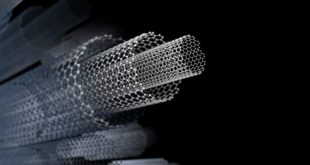The newly-discovered dinosaur species, Spicomellus afer, is the earliest-known ankylosaur and the first ankylosaur to be named from Africa. Life reconstruction of the armored dinosaur Borealopelta markmitchelli, which lived in what is now Alberta, Canada, some 110 million years ago, eating ferns. Image credit: Julius Csotonyi / Royal Tyrrell Museum. …
Read More »Layers of Graphene
To truly understand the essence of something, pelt it with projectiles. That has long been the preferred approach of some physicists, anyway. These scientists routinely study the subtle properties of solids by bombarding them with charged particles and watching for those that bounce off, get stuck or pass through to …
Read More »Water Splitting Electrocatalyst
Researchers in Japan have synthesised nanoporous ultra-high-entropy alloys that contain 14 elements. Tests showed the alloys were capable of splitting water and performed better than commercial platinum-based hydrogen evolution reaction catalysts and iridium-based oxygen evolution reaction catalysts. ‘Most conventional alloy catalysts contain a primary metal constituent with high atomic percentage, …
Read More »Vampire Bats
During nightly foraging trips, closely bonded females of common vampire bats (Desmodus rotundus) depart their roost separately, but often reunite far outside the roost to hunt together, says a new paper published today in the journal PLoS Biology. The common vampire bats (Desmodus rotundus). Image credit: Uwe Schmidt. Vampire bats …
Read More »Bipedal Dinosaurs
The tail of bipedal non-avian dinosaurs played a role analogous to the swinging arms of humans during walking and running, according to new research led by Harvard University’s Dr. Peter Bishop. Computer simulations of running locomotion in a modern tinamou bird (brown) and the extinct theropod dinosaur Coelophysis (green). Gray …
Read More »Biofluorescence
An international team of researchers led by the University of Georgia has documented ultraviolet biofluorescence in live southeastern pocket gophers (Geomys pinetis) and in museum specimens of four additional gopher species. Southeastern pocket gophers (Geomys pinetis) are biofluorescent, giving off a colored glow when illuminated with UV light. Image credit: …
Read More »Laws of Physics on Mars
Pull out your red-and-blue 3D glasses: Ingenuity’s latest, ground-hugging flight has delivered an anaglyph 3D tableau of the Martian landscape. Its mission was to take color images of a specific geological target: a 30-foot hunk of craggy orange rock that the Perseverance team has nicknamed “Faillefeu,” after a medieval abbey …
Read More »The Atlantic Puffin
Researchers have sequenced analyzed the genome of the Atlantic puffin (Fratercula arctica), a small auk with a large head and a colorful bill. Using the genome-wide resequencing data, they’ve also identified four main puffin population clusters consisting of (i) Spitsbergen (High Arctic), (ii) Canada, (iii) Isle of May, and (iv) …
Read More »Jurassic Pterosaur
Paleontologists have unearthed and described the fragmentary fossilized remains of a non-pterodactyloid pterosaur in the Atacama Desert in northern Chile. Life reconstruction of a rhamphorhynchine pterosaur from the Cerro Campamento Formation, Chile. Image credit: Universidad de Chile. The newly-described pterosaur inhabited the ancient supercontinent of Gondwana some 160 million years ago …
Read More »Pathogenic Fungi
A new study in mice shows that normally, the immune system keeps potentially pathogenic fungi such as Candida albicans in check, targeting them when they switch into a state that can cause harm; when the system is off-balance, disease is more likely to occur. Candida albicans. Image credit: Stephanie Rossow …
Read More » #Bizwhiznetwork.com Innovation ΛI |Technology News
#Bizwhiznetwork.com Innovation ΛI |Technology News









